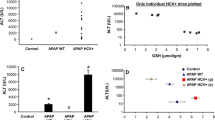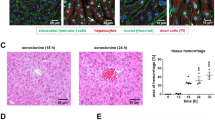Abstract
Halothane hepatitis is a rare and potentially fatal consequence to the use of this anesthetic. The physiological basis of the disease appears to be an immune response to neoantigens formed by the covalent binding of halothane metabolites to liver protein. Liver slices were used to study the condition for halothane associated neoantigen formation in vitro. Liver slices, (1 cm diameter, 300 μm thick) from male Hartley guinea pigs (600 g) were exposed to either 1.0 or 1.7 mM halothane (media concentration) in 95% O2/5% CO2 for 12 hr. Covalent binding was determined using 14C-halothane. Neoantigens were detected by western immunoblot assay using rabbit anti-trifluoroacetylated albumin antiserum. Covalent binding was detected by 1 hr of incubation and increased linearly through 12 hr. Covalent binding preceeded and correlated with the appearance of neoantigen. By 12 hr of incubation, 5 neoantigens were seen with molecular weights ranging from 51–97 kD. These neoantigens have molecular weights similar to those seen in vivo. This in vitro model system can be used to examine the mechanism for covalent binding and neoantigen production in the hepatocyte.
Access this chapter
Tax calculation will be finalised at checkout
Purchases are for personal use only
Preview
Unable to display preview. Download preview PDF.
Similar content being viewed by others
References
Della-Penna, D., Christoffersen, R.E., Bennett, A.B. (1986). Biotinylated proteins as molecular weight standards on western blots. Analytical Biochem. 152, 329–332.
Ghantous, H.N., Fernando, J., Gandolfi, A.J., Brendel, K. (1989). Toxicity of halothane in guinea pig liver slices. Toxicology, accepted.
Ghantous, H.N., Fernando, J., Gandolfi, A.J., Brendel, K. (1989). Biotransformation of halothane in guinea pig liver slices. Drug Metab., accepted.
Kenna, J.G., Neuberger, J., Williams, R. (1987). Identification by immunoblotting of three halothane-induced liver microsomal polypeptide antigens recognized by antibodies in sera from patients with halothane associated hepatitis. J. Pharm. Exp. Ther. 242, 733–740.
Kenna, J.G., Satoh, H., Christ, D.D., Pohl, L.R. (1988). Metabolic basis for a drug hypersensitivity: Antibodies in sera from patients with halothane hepatitis recognize liver neoantigen that contain the trifluoroacetyl group derived from halothane. J. Pharm. Exp. Ther. 245, 1103–1109.
Kenna, J.G., Neuberger, J., Williams, R. (1988). Evidence for expression in human liver of halothane-induced neoantigens recognized by antibodies in sera from patients with halothane hepatitis. Hepatology 8, 1635–1641.
Lind, R.C., Gandolfi, A.J., Hall, P.M. (1990). Covalent binding of oxidative biotransformation intermediates is associated with halothane hepatotoxicity in guinea pigs. Submitted, Anesthesiology.
Pohl, L.R., Satoh, H., Christ, D.D., Kenna, J.G. (1988). The immunological and metabolic basis of drug hypersensitivities. Ann. Rev. Pharmacol. 28, 367–387.
Roth, T.P., Hubbard, A.K., Gandolfi, A.J., Brown, B.R. (1988). Chronology of halothane-induced antigen expression in halothane exposed rabbits. Clin. Exp. Immunol. 72, 330–336.
Author information
Authors and Affiliations
Editor information
Editors and Affiliations
Rights and permissions
Copyright information
© 1991 Plenum Press, New York
About this chapter
Cite this chapter
Brown, A.P., Hastings, K.L., Gandolfi, A.J., Brendel, K. (1991). Covalent Binding of a Halothane Metabolite and Neoantigen Production in Guinea Pig Liver Slices. In: Witmer, C.M., Snyder, R.R., Jollow, D.J., Kalf, G.F., Kocsis, J.J., Sipes, I.G. (eds) Biological Reactive Intermediates IV. Advances in Experimental Medicine and Biology, vol 283. Springer, Boston, MA. https://doi.org/10.1007/978-1-4684-5877-0_89
Download citation
DOI: https://doi.org/10.1007/978-1-4684-5877-0_89
Publisher Name: Springer, Boston, MA
Print ISBN: 978-1-4684-5879-4
Online ISBN: 978-1-4684-5877-0
eBook Packages: Springer Book Archive




